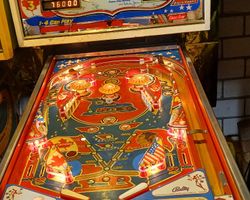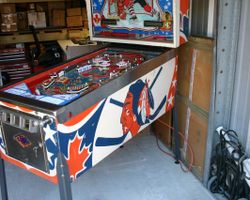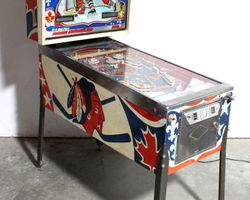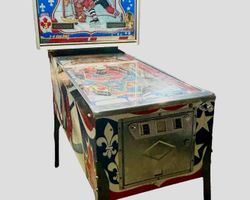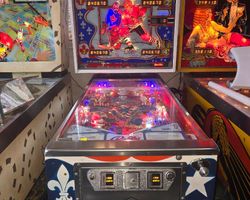Power Play
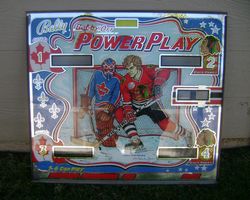
Average Prices: USD $300 to $1,500
Produced: January, 1978
Production Run: 13,750 units
Machine Type: Solid State Electronic
MPU: Bally MPU AS-2518-17
Players: 4
Design by: Greg Kmiec
Art by: Dave Christensen
"Power Play," a solid-state pinball machine manufactured by Bally Manufacturing Corporation, debuted in January 1978. This machine emerged during a transitional period for pinball, as the industry shifted from electro-mechanical (EM) designs to the more advanced solid-state (SS) electronics. Bally, a prominent name in pinball production, tasked designer Greg Kmiec and artist Dave Christensen with bringing the machine to life. Kmiec, known for his ability to craft engaging layouts, collaborated with Christensen, whose distinctive art style defined many Bally titles of the era. The machine's theme centered on the sport of hockey, specifically featuring Bobby Orr, a highly influential and accomplished figure in professional hockey from the mid-1960s to late 1970s. Orr's widespread recognition and popularity in North America significantly contributed to the machine's immediate appeal.
"Power Play" (Bally model number 1120-E) was built upon the Bally MPU AS-2518-17 board, a common platform for Bally's early solid-state games. Its production run was substantial for its time, with 13,750 units manufactured. This robust production figure underscored both Bally's confidence in the emerging solid-state technology and the broad market interest in a theme anchored by a popular sports personality. Despite some initial apprehension among operators regarding the maintenance and reliability of the newer solid-state systems compared to their simpler EM predecessors, "Power Play" found considerable success in arcades and public venues. It holds a notable place in pinball history as only the second solid-state game to incorporate an up-post mechanism between the flippers, a feature previously seen on Sega Enterprises' 1976 "Rodeo." This blend of established pinball mechanics with novel electronic features marked "Power Play" as a significant step in pinball's evolution.
Signature Features and Design
"Power Play" distinguishes itself with several unique design elements that enhance its gameplay and thematic presentation. A prominent feature is the inclusion of four flippers: two standard-sized flippers at the bottom of the playfield and two smaller, upper mini-flippers positioned higher up. These upper flippers provide additional shot opportunities and strategic depth, allowing players to attempt precise shots at targets that might otherwise be inaccessible. The most thematically integrated feature is the center pop-up post located between the main flippers. This post, designed to rise at strategic moments during gameplay, simulates a "Power Play" scenario, creating a moment of heightened tension and opportunity for the player.
Visually, the machine is defined by Dave Christensen's artwork, which immerses the player in the world of hockey. The backglass and playfield art feature dynamic depictions of hockey players in action, dominated by the likeness of Bobby Orr. While the artwork generally received praise for its energy and thematic accuracy, some observant players noted a minor artistic inaccuracy: Bobby Orr is depicted wearing a Blackhawks jersey, despite playing the majority of his prominent career with the Boston Bruins. Despite this detail, the overall aesthetic is vibrant, with a color palette that evokes the ice and energy of a hockey game. Adding to its distinct character, "Power Play" utilizes a chime sound system, characteristic of earlier Bally solid-state machines. This choice provides a familiar, satisfying auditory experience, bridging the gap between traditional EM chimes and the more complex synthesized sounds that would become prevalent in later solid-state games.
Playfield and Mechanics
The "Power Play" playfield presents a highly symmetrical layout, a common design approach during this era of pinball manufacturing. This symmetry contributes to a clear, direct ball flow that is easy for new players to grasp while still offering challenges for seasoned players. At the heart of the playfield are two distinct banks of four drop targets each, positioned on either side of the central vertical axis. These drop targets serve as primary objectives, requiring players to accurately hit them to light scoring opportunities and advance game progression.
Above the main flippers, the two smaller, upper flippers are strategically placed to allow for shots at specific targets or to set up combos. This arrangement encourages players to master shots from both the lower and upper flippers to maximize their score and complete objectives. A kick-out hole is situated in the upper playfield, feeding balls back into play from a high-scoring target area. Ten star rollovers are scattered across the playfield, activating points and features when traversed by the ball. Three pop bumpers provide chaotic yet exciting ball movement, while two slingshots propel the ball back into the active playfield area. A standup target also provides a direct target for players seeking quick points. The playfield's aesthetic, with its bold lines and energetic hockey-themed illustrations, guides the player's eye toward key scoring areas and enhances the overall immersive experience of a fast-paced game. The lighting, though simpler than later machines, effectively highlights activated targets and scoring zones, providing clear visual feedback to the player.
Gameplay Dynamics
"Power Play" offers a straightforward yet engaging gameplay experience centered around clearing drop targets and capitalizing on the unique "Power Play" feature. The primary objective for players is to systematically knock down the two banks of four drop targets. Completing a bank of targets often activates higher scoring opportunities, unlocks special features, or lights the kick-out hole for a high-value shot. The symmetrical layout, while simple, creates a consistent ball flow, making it easier for players to anticipate shots and develop repeatable strategies.
The game's namesake "Power Play" comes into effect when the up-post between the flippers rises, an event that can be triggered by specific shots or conditions on the playfield. When the post is up, it offers a temporary safeguard against draining the ball between the flippers, allowing for a more aggressive play style and potentially setting up high-scoring opportunities without immediate risk of a lost ball. This moment of enhanced safety encourages players to go for riskier shots, mimicking the strategic advantage of a real-life hockey power play. The upper mini-flippers are crucial for targeting the upper drop targets and the kick-out hole, requiring precision and timing. Mastering the angle and power needed for these shots is key to achieving high scores and progressing through the game's objectives. Scoring is displayed digitally, with a maximum of 999,990 points per player, pushing players to optimize their shots and capitalize on every opportunity to clear targets and hit the high-value kick-out hole.
Reception and Legacy
"Power Play" was generally well-received by the pinball community, particularly upon its release and throughout its active arcade life. Its strengths were often highlighted, including its fast and enjoyable gameplay, which many players found to have excellent ball flow. It earned a reputation as a solid early solid-state (SS) machine, appreciated for retaining some of the tactile charm of electro-mechanical (EM) games, notably through its chime sound system, which many preferred over the nascent electronic sounds of some contemporary SS titles. The hockey theme, especially with the inclusion of Bobby Orr, resonated strongly with sports fans and contributed significantly to its broad appeal. The artwork, executed by Dave Christensen, was largely praised for being vibrant and fitting for the theme, creating an engaging visual experience.
Specific features frequently lauded included the innovative upper mini-flippers, which provided unique shot angles and added strategic depth, and the central pop-up post that created the thematic "Power Play" moments, adding excitement and a temporary reprieve from drains. The presence of multiple drop target banks also provided clear objectives that players enjoyed pursuing. Many players found the game's straightforward rules and clear objectives made it accessible for beginners, allowing them to quickly grasp the fundamentals while still offering enough challenge to keep experienced players engaged.
Despite its positive reception, "Power Play" did receive some critical feedback. A common observation was the highly symmetrical layout of the playfield. While contributing to predictable ball flow, some players found this symmetry led to a somewhat repetitive gameplay experience over prolonged sessions, arguing that it lacked the varied shot possibilities found in more complex designs. The reliance on the upper scoop as a primary high-scoring shot was also noted by some as potentially limiting the diversity of viable strategies. A minor, though frequently mentioned, detail was the artistic inaccuracy of Bobby Orr wearing a Blackhawks jersey instead of his more associated Bruins uniform, and one observation regarding his stick-holding. While the chimes were appreciated, the overall sound effects package was sometimes perceived as basic when compared to the evolving audio capabilities of later solid-state machines. Nevertheless, "Power Play" secured its place as a significant early solid-state title, effectively bridging the design philosophies of the EM era with the burgeoning electronic capabilities of the SS generation. Its enduring appeal lies in its combination of classic pinball elements with early SS innovations, making it a memorable example of late 1970s pinball design.
Sponsored Links
 Ebay Listings
Ebay Listings
 Auction Results
Auction Results
| Cost | Location | Date |
|---|---|---|
| USD $2,150 |  Georgia, United States Georgia, United States |
10 December, 2025 |
| EUR €1,890 |  Nordrhein-Westfalen, Germany Nordrhein-Westfalen, Germany |
23 September, 2025 |
| EUR €2,100 |  Baden-Württemberg, Germany Baden-Württemberg, Germany |
26 January, 2025 |
| USD $1,995 |  California, United States California, United States |
18 January, 2025 |
| EUR €1,990 |  Nordrhein-Westfalen, Germany Nordrhein-Westfalen, Germany |
08 December, 2024 |
| USD $1,240 |  Arizona, United States Arizona, United States |
15 October, 2024 |
| USD $1,300 |  Florida, United States Florida, United States |
20 September, 2024 |
| CAD $3,000 |  Canada Canada |
09 September, 2024 |
| USD $550 |  Michigan, United States Michigan, United States |
30 August, 2024 |
| USD $1,900 |  Indiana, United States Indiana, United States |
29 June, 2024 |


Private Policy · Search Website · Contact Us
As an eBay Partner, we may earn a commission from qualifying purchases made through links on this site, at no additional cost to you.
All trademarks and copyrighted materials remain property of their respective owners. All other content copyright 2007 - 2025 Pinpedia.

